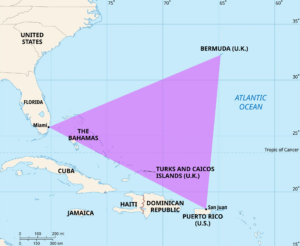The Bermuda Triangle, a region steeped in mystery and intrigue, has captivated the imagination of people around the world for decades. Spanning a loosely defined area in the western part of the North Atlantic Ocean, this enigmatic triangle has become synonymous with unexplained disappearances of ships and aircraft. But is the Bermuda Triangle truly a hotspot for paranormal or extraterrestrial activity, or are the incidents within its boundaries mere coincidences and misinterpretations? In this article, we will delve into the history, popular theories, and scientific explanations surrounding the Bermuda Triangle.

A Brief History
The Bermuda Triangle’s vertices are typically considered to be Miami, Florida; San Juan, Puerto Rico; and the island of Bermuda, although the exact boundaries can vary. The area first gained notoriety in the early 20th century when several high-profile disappearances, such as the USS Cyclops in 1918 and Flight 19 in 1945, captured the public’s attention. These incidents, along with numerous others, have led to widespread speculation about the causes of the disappearances, ranging from natural phenomena to human error and paranormal activity.
Popular Theories
- Compass Variation: One theory proposes that the Bermuda Triangle is unique due to the alignment of true north and magnetic north, which can create navigational challenges for inexperienced pilots or sailors. This compass variation might be responsible for some of the disappearances in the area.
- Supernatural or Extraterrestrial Activity: Some people believe that the Bermuda Triangle is a hotspot for paranormal or extraterrestrial encounters, leading to the sudden and unexplained disappearances of ships and aircraft. While these theories are popular in pop culture, they lack scientific evidence and are often dismissed by experts.
Scientific Explanations
- Human Error: Considering the high volume of maritime and air traffic in the region, it is plausible that many accidents and disappearances can be attributed to human error, such as miscommunication or navigational mistakes.
- Weather and Oceanic Conditions: The Bermuda Triangle is known for its unpredictable and rapidly changing weather, with sudden storms, hurricanes, and waterspouts posing significant hazards. Additionally, the powerful Gulf Stream current can contribute to sudden changes in weather and ocean conditions, making navigation challenging.
- Methane Hydrates: Some researchers suggest that underwater methane hydrate deposits could be responsible for certain ship disappearances. If these ice-like structures were to suddenly release methane gas, they could potentially reduce the water’s density and cause ships to sink. However, this theory remains speculative and has not been proven conclusively.
Fact or Fiction?
While the Bermuda Triangle’s reputation for mysterious disappearances is well-established, many experts argue that the number of incidents is not significantly higher than in other busy ocean regions. In fact, several comprehensive studies have shown that the rate of disappearances in the Bermuda Triangle is comparable to other areas with similar levels of air and sea traffic.
Conclusion
The Bermuda Triangle, with its enigmatic history and puzzling incidents, will likely continue to captivate the public’s imagination for years to come. However, when considering the scientific explanations and statistics, it becomes clear that the mystery surrounding the Bermuda Triangle may be more a product of myth and folklore than actual unexplained phenomena. As we continue to explore and better understand our world, the mysteries of the Bermuda Triangle will likely fade, replaced by rational explanations and a deeper understanding of the natural world.


